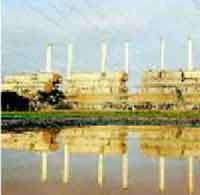Friday 26/12/2008 Page: 8
 THE war of words over "clean coal" technology has escalated with the launch of a new website by US environmentalists proclaiming: In reality, there is no such thing as clean coal." The site, www.thisisreality.org, is sponsored by prominent US conservation organisations, including the National Wildlife Federation, the Sierra Club and the Natural Resources Defense Council.
THE war of words over "clean coal" technology has escalated with the launch of a new website by US environmentalists proclaiming: In reality, there is no such thing as clean coal." The site, www.thisisreality.org, is sponsored by prominent US conservation organisations, including the National Wildlife Federation, the Sierra Club and the Natural Resources Defense Council.The website links to a spoof video on clean coal showing an engineer walking through a door to a "clean coal facility". It opens onto a windswept empty landscape as he says: "Take a good long look. This is today's clean coal technology."
The Rudd Government is heavily promoting clean coal technology as the answer to the industry's problems with high greenhouse gas emissions. It launched it biggest clean coal initiative last month, setting up a new research institute in Australia at a cost of $100 million a year for the next four years. It is also strongly lobbying the UN to allow countries such as Australia and Japan to offset their greenhouse gas emissions with investments in "clean coal" technology.
The launch of the environmentalists' website is a response to lobbying by US coal and power companies to promote clean coal technology and argue against laws to cut greenhouse gas emissions. The American industry has launched a $US45 million ($66 million) television advertising campaign tagged "I Believe" which promotes the technology as the answer to the greenhouse crisis with the slug line: "Clean Coal. America's Power." The campaign is sponsored by 48 coal and power companies that make up the American Coalition for Clean Coal Electricity.
Last month the Australian Coal Association launched an interactive website, www.newgencoal.com.au, promoting its campaign to develop technology to clean up emissions from coal-fired power. Significantly, the Australian industry dropped the phrase "clean coal". Market research found the public were confused about the idea of "clean coal" so it decided to use the expression "new generation coal" instead.
We believe it is important that there is a strong focus on, and understanding of, the new generation of coal technologies rather than a phrase that creates confusion," the head of the Australian Coal Association, Ralph Hillman, said at the launch of the website.
Coal-fired power stations in Australia are the greatest single source of the country's greenhouse gas emissions but the black coal industry is also concerned that its vital export markets in countries such Japan could be jeopardised in the future if greenhouse emissions front coal cannot be contained.
The Australian industry website, however, promotes the same "carbon capture and storage" technology as the US industry which is designed to capture about 85% of greenhouse gas emissions from coal-fired power stations and then bury them.
Critics, such as the US environment groups, say there are no commercial clean coal plants in the world and, on best estimates, it is unlikely the technology will be commercially viable until after 2020. The International Energy Agency recently estimated that at least $US20 billion would need to be invested in clean coal technology in order to get viable demonstration plants operating in the near future.


